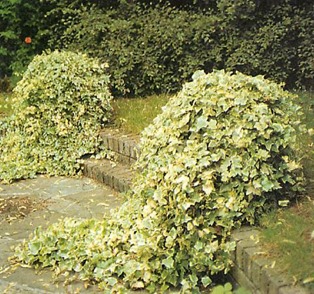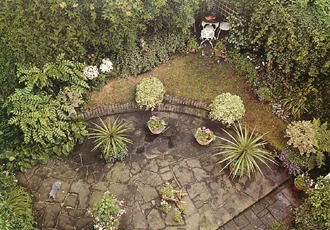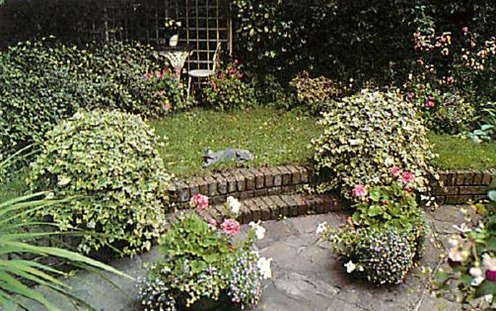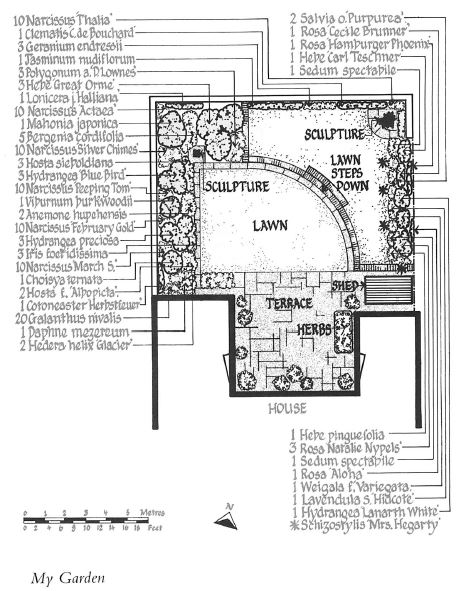





This first design is the very reason I became seriously interested in low-maintenance gardening. I was impressed by the ease with which the garden took care of itself (rather than my taking care of it), and overwhelmed by the year-round fragrance, colour and variety it offered in exchange for so little work. It was all these qualities that contributed to my obsession with gardens that are planned, built, laid out and planted with the correct choice of flowers and shrubs, in such a way that they do not rule your life.
Not many garden lovers can sit outside and just enjoy the garden for long without being tempted to jump up and do some small job that they feel needs to be done, but for those who are not addicted to gardening a ‘little work’ garden is there to be enjoyed.
My garden was laid out in 1969 and it has deteriorated very little over the years, considering it has only had the odd plant replaced and often been neglected cruelly for months on end.
Apart from a good organic feed in March, pruning, watering and seasonal planting of the tubs in May, it has been left year in year out to struggle or flourish as it will.
I confess that some of this neglect is due to my involvement in the as yet untamed six acre (2.5 hectare) garden outside London, which has meant that this garden has seen less than six hours of my love and attention a year and has been forced to take care of itself. Yet it has proved unquestionably that it is a successful ‘trouble free’ garden. But that goes without saying as it was so well thought out and planned in the first place.
 Years ago I had two dingy back yards behind the two Victorian artisan’s cottages in which I live. The yards were on three different levels, with poor soil, a variety of straggly and unsuitable plants, and shaded by huge overhanging lime trees which not only took the goodness from the soil, but also produced an aphid excretion in the summer which made everything beneath sticky and black. There was no area in which to sit and there were slugs and snails everywhere. At one time there had been a ‘privy’ or outside toilet in the garden and a bicycle shed, the remains of which were falling down in one corner.
Years ago I had two dingy back yards behind the two Victorian artisan’s cottages in which I live. The yards were on three different levels, with poor soil, a variety of straggly and unsuitable plants, and shaded by huge overhanging lime trees which not only took the goodness from the soil, but also produced an aphid excretion in the summer which made everything beneath sticky and black. There was no area in which to sit and there were slugs and snails everywhere. At one time there had been a ‘privy’ or outside toilet in the garden and a bicycle shed, the remains of which were falling down in one corner.
I had bought the second cottage in the early sixties from my neighbours, a couple who were pensioners and whose family had lived in the street since the cottages were built over a hundred years ago. In the old days there were vegetables, chickens, outside loo and a clothes line in the back yards, before developers bought the cottages and converted them.
 The problems presented to the designer were the mature overhanging lime trees and the varying levels of the garden – although the cottages were on the same level, the back yards had in places a discrepancy of 12 in to 18 in (30 to 45 cm). There were patches of crazed concrete, and low brick walls that had fallen down. The dilapidated shed, permanent puddles on compacted poor soil, ill-assorted trellis, builders’ debris, bricks and slates didn’t help either. The area, which was 30 ft (9 m) deep and 60 ft (18 m) wide, was an unsightly mess.
The problems presented to the designer were the mature overhanging lime trees and the varying levels of the garden – although the cottages were on the same level, the back yards had in places a discrepancy of 12 in to 18 in (30 to 45 cm). There were patches of crazed concrete, and low brick walls that had fallen down. The dilapidated shed, permanent puddles on compacted poor soil, ill-assorted trellis, builders’ debris, bricks and slates didn’t help either. The area, which was 30 ft (9 m) deep and 60 ft (18 m) wide, was an unsightly mess.
I wanted a garden that demanded very little time, as I was often away working or working round the clock at the studio. I wanted a place to sit. I didn’t want to have to put in different plants in the summer, then replace them in the autumn or have to do a lot of digging. My dream was to spend less than an hour a week on it and still have a beautiful garden.
Only during the establishing years was I obliged to devote a certain amount of time to weeding. But ultimately the garden demanded less than an hour a month and yet was still interesting and pleasant the year round.
One of my first requests for the garden, apart from the fact that I wanted it to be easy, was roses. I love roses, but unfortunately in such an enclosed area, with little or no breeze being able to circulate, roses tend to struggle for life rather than flourish in the garden.
Time has shown that climbing roses, which can get their heads above the wall and into the air and light, do extremely well providing they are fed with Top Rose or bonemeal each year. So a number of climbing roses were added to the original planting plan. In the early stages, climbing roses need training and cutting, two jobs that at the beginning were not on my list of things I was prepared to do in this ‘little work’ garden. But for the very little effort they have cost me, twenty years later, I am still enjoying their beauty and am delighted they were planted.
This simple, elegant design has brilliantly married the two levels of the walled garden together and banished completely the desolated look of neglected back yards.
As you look from the terrace at the back of the house over the two-tier garden, the sweeping raised crescent moon in the corner cleverly exploits the change of levels, and thus this built-up area is transformed into a pleasant sitting arbour, which has the sun in the summer until at least seven or eight o’clock and is a perfect place to enjoy a quiet read or late tea.
The wooden trellis on two sides of the arbour provides strong support for the Jasminum officinale and Clematis montana rubens, plus some welcome shade to cool this sun trap on sunny days. On the opposite side the densely planted lush foliage and statue complement the sun-filled sitting area.
Walking across the grass to the house from the arbour you go down two brick steps to the second grass area. The interesting outline of the grass is emphasised by bricks laid on the edge making a flat ‘mowing stone’ to facilitate cutting the grass.
The small shed for garden implements, lawn mower and dustbins on the right of the terrace is camouflaged by the tubs in front. Utilities such as a barbecue and clothes line were not required so a space didn’t need to be found for them.
One of the first moves we made before moving or levelling the soil of the back yards was to ask the local council to reduce the canopy of the overhanging lime trees growing in the grounds behind the terrace. In my case it was an essential step to let in both rain and light.
Trees are sometimes the cause of problems but the principles behind these are reasonably well defined in law. If a tree overhangs a neighbouring property, the neighbour can cut the branches or the roots back to the boundary. The cut off parts still belong to the tree’s owner, as do the fruits, apples, and so on, on a fruit tree! In the interests of neighbourly relations, it is advisable to tell the tree’s owner your intention to cut it, but this is not a legal duty.
Trees in the street and in adjoining council property are the council’s responsibility. But a tree in your own garden may have a preservation order on it, so make enquiries before starting work on the garden. Make sure you use an experienced tree surgeon to do this sort of work.
We have so few fine days in England that when they do come it’s nice to be outside but not, needless to say, on grass that is soaking wet from rain the day before. So a paved terrace is essential. Chairs and tables need to stand on a hard surface as no one (not even the lawn) wants to have heels and chair legs sinking into the grass.
Like every garden, this one has evolved with time. Jardinieres have been added, plants that have died in the frost have been replaced, a sculpture removed, and a conservatory built, greatly reducing the size of the original terrace.
The years have seen climbing frames, portable sand pits, children’s parties and picnics on the grass, to say nothing of tents, caged rabbits and wandering tortoises.

At one time the little grass lawn was used for football and swingball to such an extent that it had to be paved over with York stone to avoid the muddy shoes treading in and out of the house. I came by my York stone in a curious way. Many years ago when the council were sadly ripping up the York stone paving slabs outside the stage door of the theatre where I was working, the workmen told me the smaller pieces were to be discarded and if I wished I could take them home. So each night I loaded the boot of my car – ruining the suspension in the process – and took home small sections of York stone which now cover the lower grass area as well as the brick ‘mowing stone’, which was destroyed by youngsters trying to play football.
But none of these changes has been fatal. They have left their mark, which is as it should be, as gardens are there to be used as an extension of the house.
The plants listed below are the plants that have flourished despite neglect over the past 20 years in my pink, white and blue garden, and not had to be replaced.
T = Trouble free
Lonicera japonica ‘Halliana’ Height 25-30ft (7.5-9 m) Sweet-smelling cream flowers from June to October. Semi-evergreen, mid-green leaves. Good camouflage climber and will grow anywhere.
T Hydrangea pctiolaris Self-clinging hardy deciduous climber. In the wild it can grow to 60ft (18 m) but is easily pruned. Attractive picturesque plant to clothe walls or fences and will grow on north- and east-facing walls without complaining. Flat heads of cream-white flowers in June. Dark green leaves, flaky brown stems. Prefers damp wall and shade, and needs a few ties as it grows: if the wall is too dry it may fall away.
T Jasminum nudiflorum (Winter jasmine). Hardy deciduous climber that needs training and support. Grows to 10ft (3m). Yellowflowers which make a dazzling display in winter on naked green branches. Tiny oval three-fingered dark green leaves. Prune after flowering to keep it tidy. Tolerates sun or shade.
T Jasminum officinale Hardy deciduous vigorous climber. Grows to 30ft (9m). Mid-green leaves. Sweet-smelling clusters of small white star-like flowers from June to October. Best in sunny position for more flowers.
Climbing Rose Aloha Height 7- 10ft (2.25-3 m). Rich pink, very full flowers with strong perfume from June onwards. Shiny green leaf. (Also good as a large shrub).

T Mahonia japonica Evergreen shrub, happy in sun or shade. Long dark green holly-like leaves. Height 6-8ft (2-2.5m). Spread 6-8ft (2-2.5 m). Long pendulous clusters of lemon yellow flowers with lily of the valley scent. Wonderfully easy and dramatic shrub. Don’t be afraid to cut it back after flowering to keep it bushy. But I haven’t cut mine more than twice in 20 years!
T Hebe ‘Great Orme’ Evergreen shrub. Grows to 4ft (1.2m). Spread 3-4ft (90cm-1.2m). Dark green fleshy leaves, pink flowers on spikes from May to July. Tolerates all conditions, even maritime, but not extreme cold. Hebe pinguifolia has white flowers on spikes in May.
T Daphne mezereum (Mezereon) Deciduous shrub. Height 5ft (1.5m) spread 2-4 ft (60cm-1.2m). Sweet-smelling pink/purple flowers from February to March, followed by poisonous scarlet fruit. Light green leaves with grey/green underside.
T Cotoneaster ‘Autumn Fire’ Evergreen shrub. Grows to 15 ft (4.5 m) if supported, or 3 or 4ft (90 cm -1.2 m) as ground cover. Dark green leaves, tiny white flowers in May, red fruits (loved by the birds) in autumn. Tolerates shade or sun.
T Choisya tcrnata (Mexican orange blossom) Wonderful evergreen bushy shrub with aromatic shiny dark green leaves. Height 6-8ft (2-2.5m) and spread 6-8ft (2-2.5m), but it has grown to almost 18ft (5.5m) in this garden. Sweet-smelling white flowers in May and sporadically throughout the summer and autumn. Tolerates both shade and sun – a most obliging shrub. Doesn’t like soggy soil.
T Viburnum burkwoodii Evergreen shrub. Height up to 8ft (2.5 m). Spread 8- 12ft (2.5 to 3.5 m). Sweet-smelling clove-scented white flower clusters (pink when in bud) from January to May. Excellent hardworking shrub. Dark green leaves with brown/grey felt underside. Tolerates shade or sun. In this garden it is trained as a climber.
T Hydrangea ‘Blue Bird’ Deciduous shrub. Height up to 2ft 6in (15cm). Spread 2ft Sin (75 cm). Delightful blue lace-cap flowers in July. This shrub prefers shade but tolerates some sun. Mid-green leaves. All hydrangeas make excellent dried flowers and do need plenty of moisture.
T Hydrangea ‘Lanarth White’ Deciduous shrub. Height about 3ft (1m). Nice compact habit. White lace-cap flowers from July to October. Pale green leaves. Unlike many hydrangeas this variety flowers best in sun.
T Weigela Florida ‘Variegata’ Deciduous shrub. Height 4-5ft (1.2-1.5in). Spread 4-5ft (1.2 m-1.5m). Mid-green leaves with broad cream/white margins. Attractive and obliging shrub with pale pink foxglove-like flowers May and June.
Bergenia cordifolia (Elephants’ Ears). Excellent evergreen ground cover. Pink and red flowers in spring. Large flat dark green leaves. Handsome ground cover, except once twelve years ago when it was attacked by snails.
T Hedera helix ‘Glacier’ (Ivy) Ground cover or for a shady wall. Silver grey leafed ivy. This variety will grow to 5- 10ft (1.5-3in).
T Sedum spectabile Hardy herbaceous plant. Height 12-18 in (30-45cm). Spread 15 in (37.5 cm). Pink head of flowers 3-5in (7.5-12.5cm) across from September to October. Fleshy silver/green leaves. Brings welcome autumn colour.
T Salvia officinalis purpurea (Sage) Evergreen small shrub. Purple leafed sage, obliging ground cover. Height 18in (45cm), spread 18 in (45cm). Blue purple flowers in June and July. Prefers sun.
T Hosta sieboldiana Herbaceous perennial. Excellent low-growing late spring and summer ground cover plant. Broad silver/blue leaves, pale lilac flowers in July to August. Can grow 2ft by 2ft (60 by 60cm). Both shade and sun-loving.
The deciduous shrubs are underplanted with snowdrops and miniature cyclamen and spring flowering bulbs.
Copyright © www.100flowers.win Botanic Garden All Rights Reserved